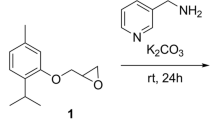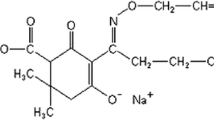Abstract
The present study examines the toxicity of HgCl2, using in vitro grown lymphocytes from human umbilical cord blood. Lymphocytes were diluted with Dulbecco’s modified Eagle’s medium, and were grown in the presence of grading doses of HgCl2. The cell-toxicity on grown lymphocytes was assessed using three staining procedures, trypan blue (TB) assay, acridine orange/ethidium bromide (AO/EB) staining and propidium iodide (PI) staining cytologically; and 3-(4,5-dimethylthiazol-2-yl)2,5-diphenyltetrazolium bromide (MTT) assay. The standard procedure was carried out for monitoring the live cell density. Additionally, the comet assay was done to ascertain levels of HgCl2 in inducing the nuclear disruption of lymphocytes. Mean results of three independent experiments are presented. Probit-computed lethal concentration (LC) values obtained were in ranges, 5.00–16.22 mg/l as LC25, 13.18–24.54 mg/l as LC50, and 25.12–34.67 mg/l HgCl2 as LC75, respectively at 24 h with incubation with HgCl2, using TB, AO/EB, PI staining procedures and the MTT assay. Experimentally, the minimum inhibitory concentration (MIC), the highest permissive concentration (HPC) and the LC100 values were in ranges, 5, 35–40 and 40–45 mg/l, respectively, for cytotoxicity. With comet assay data, the MIC value was 5 mg/l, whereas the HPC and LC100 values were 35 and 40 mg/l, respectively; and LC25, LC50 and LC75 values were 15.48, 20.41 and 28.84 mg/l HgCl2, respectively. Thus, HgCl2 levels higher than 5 mg/l and below 40–45 mg/l were toxic to in vitro cultured human lymphocytes.









Similar content being viewed by others
References
Edwards JH, Someswar AV (2000) Chemical, physical and biological characteristics of agricultural and forest by-products for land application. In: Dick WA (ed) Land application of agricultural, industrial and municipal by-products, vol SSSA Book Series 6. SSSA, Madison, pp 1–62
Syversen T, Kaur P (2012) The toxicology of mercury and its compounds. J Trace Elem Med Biol 26:215–226
Navarro M, Lopez H, Sanchez M, Lopez MC (1993) The effect of industrial pollution on mercury levels in water, soil and sludge in the coastal area of Motril, Southren Spain. Arch Environ Contam Toxicol 24:11–15
Anonymous (2008). Children’s health and the environment WHO training package for the health, Health Sector, World Health Organization. www.who.int/ceh. Accessed on 27 Nov 2013
Zaki LA, Majeed MA, Clarkson TW, Greenwood MR (1978) Methyl mercury poisoning in Iraqi children: clinical observations over two years. Br Med J 1:613–616
Yasutake A, Nakamura M (2011) Induction by mercury compounds of metallothioneins in mouse tissues: inorganic mercury accumulation is not a dominant factor for metallothionein induction in the liver. J Toxicol Sci 36:365–372
Shi JZ, Kang F, Wu Q, Lu YF, Liu J, Kang YJ (2011) Nephrotoxicity of mercuric chloride, methyl mercury and cinnabar-containing Zhu-Sha-An-Shen-Wan in rats. Toxicol Lett 200:194–200
Cruz FF, Leite CE, Pereira TCB, Bogo MR, Bonan CD, Battastini AMO et al (2013) Assessment of mercury chloride-induced toxicity and the relevance of P2X7 receptor activation in zebra fish larvae. Comp Biochem Physiol Part C 158:159–164
Trebucobich MS, Hazelhoff MH, Chevalier AA, Passamonti S, Brandoni A, Torres AM (2014) Protein expression of kidney and liver bilitranslocase in rats exposed to mercuric chloride—a potential tissular biomarker of toxicity. Toxicol Lett 225:305–310
Jones L (1999) Health outcomes following amalgam removal. New Zealand Psycho J Sept. http://www.melisa.org/articles/ljones.pdf. Accessed on 25 Nov 2013
Clarkson TW, Vyas JB, Ballatori N (2007) Mechanisms of mercury disposition in the body. Am J Ind Med 10:757–764
Takizawa Y, Kitamura S (2001) Estimation of the incidence of mercury exposure in the Minamata and Niigata areas using mathematical model from Iraqi poisonings. In: Takizawa Y, Osame M (eds) Understanding Minamata disease: methyl mercury poisoning in Minamata and Niigata. Japan Public Health Association, Tokyo, pp 27–32
Bjomberg AK, Vahter M, Graw P, Berglund M (2005) Methylmercury exposure in Swedish women with high fish consumption. Sci Total Environ 341:45–52
Jedrychowski WA, Perera FP, Pac A, Jacek R, Whyatt RM, Spengler JD (2006) Variability of total exposure to PM related to indoor and outdoor pollution sources. Krakow study in pregnant women. Sci Total Environ 366:47–54
Morgan DL, Price HC, Fernando R, Chanda SM, O’Connor RW, Barone SS, Herr DW, Beliles RP (2006) Gestational mercury vapour exposure and diet contribute to mercury accumulation in neonatal rats. Environ Health Perspect 114:735–739
Spielmann H, Seiler A, Bremer S, Hareng L, Hartung T, Ahr H, Faustman E, Haas U, Moffat GJ, Nau H, Vanparys P, Piersma A, Sintes JR, Stuart J (2006) The practical application of three validated in vitro embryotoxicity tests. The report and recommendations of an ECVAM/ZEBET workshop (ECVAM workshop 57). Altern Lab Anim 34:527–538
Imai K, Kusakawa S, Tanoue A, Kuwagata M, Senuma M, Furuya M, Takashima H (2008) In vitro embryotoxicity testing of mercury vapour by differentiation of ES-D3 cells. AATEX 13:118–122
Grandjean P, Budtz-Jorgensen E, Jorgensen PJ, Weihe P (2005) Umbilical cord mercury concentration as biomarker of prenatal exposure to methylmercury. Environ Health Perspect 113:905–908
Hassauer M, Kaiser E, Schneider K, Schuhmacher-Wolz U (2012) Collate the literature on toxicity data on mercury in experimental animals and humans. Part I—data on organic mercury. External scientific report. Supporting publications 2012: EN-297. Fobig, www.efsa.europa.eu/publications. Research and advisory institute for hazardous substances (FoBig- Forschungs - und Beratungsinstitut Gefahrstoffe)
Bieback K, Kern S, Klüter H, Eichler H (2004) Critical Parameters for the isolation of mesenchymal stem cells from umbilical cord blood. Stem Cells 22:625–634
Rath S, Sahu MC, Dubey D, Debata NK, Padhy RN (2011) Which value should be used as the lethal concentration 50 (LC50) with bacteria? Interdiscip Sci Comput Life Sci 3:138–143
Tice RR, Agurell E, Anderson D, Burlinson B, Hartmann A, Kobayashi H, Miyamae Y, Rojas E, Ryu JC, Sasaki YF (2000) Single cell gel/comet assay: guidelines for in vitro and in vivo genetic toxicology testing. Environ Mol Mutagen 35:206–221
Broxmeyer HE, Douglas GW, Hangoc G, Cooper S, Bard J, English D, Arny M, Thomasii L, Boyse EA (1989) Human umbilical cord blood as a potential source of transplantable hematopoietic stem/progenitor cells. Proc Natl Acad Sci USA 86:3828–3832
Bartosiewicz M, Penn S, Buckpitt A (2001) Applications of gene arrays in environmental toxicology: fingerprints of gene regulation associated with cadmium chloride, benzo(a)pyrene, and trichloroethylene. Environ Health Perspect 109:71–74
Liebsech M, Spielmann H (2002) Currently available in vitro methods used in the regulatory toxicology. Toxicol Lett 127:127–134
Rosler ES, Fisk GJ, Ares X, Irving J, Miura T, Rao MS, Carpenter MK (2004) Long-term culture of human embryonic stem cells in feeder-free conditions. Dev Dyn 229:259–274
Park EJ, Park K (2007) Induction of reactive oxygen species and apoptosis in BEAS-2B cells by mercuric chloride. Toxicol In Vitro 21:789–794
Bucio L, Garcıa C, Souza V, Hernandez E, Gonzalez C, Betancourt M, Gutierrez-Ruiz MC (1999) Uptake, cellular distribution and DNA damage produced by mercuric chloride in a human fetal hepatic cell line. Mutat Res 423:65–72
Carranza-Rosales P, Said-Fernandez S, Sepulveda-Saavedra J, Cruz-Vega DE, Gandolfi AJ (2005) Morphologic and functional alterations induced by low doses of mercuric chloride in the kidney OK cell line: ultrastructural evidence for an apoptotic mechanism of damage. Toxicology 210:111–121
Scanu M, Mancuso L, Cao G (2011) Evaluation of the use of human mesenchymal stem cells for acute toxicity tests. Toxicol In Vitro 25:1989–1995
Knazicka Z, Forgacs Z, Lukacova J, Tvrda E, Lukacova A, Ocztos G, Racz M, Slivkova J, Massanyi P (2012) The mercury as endocrine disruptor on the adenocarcinoma cell line H295R. J Microbiol Biotechnol 1:651–660
Hemdan NY, Lehmann I, Wichmann G, Lehmann J, Emmrich F, Sack U (2007) Immunomodulation by mercuric chloride in vitro: application of different cell activation pathways. Clin Exp Immunol 148:325–337
Son HY, Lee S, Park SB, Kim MS, Choi EJ, Singh TSK, Bae Y, Kwack SJ, Kang TS, Shin HI, Baek MC, Kim SH (2010) Toxic effects of mercuric sulfide on immune organs in mice. Immunepharmacol Immunetoxicol 32:277–283
Colombo M, Hamelin C, Kouassi E, Fournier M, Bernier J (2004) Differential effects of mercury, lead, and cadmium on IL-2 production by Jurkat T cells. Clin Immunol 111:311–322
Acknowledgments
The authors are grateful to IMS and Sum Hospital, Bhubaneswar for facilities. Especially thanks are due to all faculties of Department of O and G, and Head, Prof. Dr. Sanjukta Mohapatra, IMS and Sum Hospital, for umbilical cord blood, and to Mr. R.R. Swain, Department of Biochemistry, IMS and Sum Hospital for cooperation in data recording. R. Patnaik is supported by an INSPIRE Fellowship from DST, Govt. of India, New Delhi (Code no. IF120548). R.N. Padhy is a CSIR scientist. This study was approved by the institutional ethical committee.
Conflict of interest
The authors declare that they have no conflict of interest.
Author information
Authors and Affiliations
Corresponding author
Rights and permissions
About this article
Cite this article
Patnaik, R., Padhy, R.N. Cellular and Nuclear Toxicity of HgCl2 to In Vitro Grown Lymphocytes from Human Umbilical Cord Blood. Proc. Natl. Acad. Sci., India, Sect. B Biol. Sci. 85, 821–830 (2015). https://doi.org/10.1007/s40011-015-0503-3
Received:
Revised:
Accepted:
Published:
Issue Date:
DOI: https://doi.org/10.1007/s40011-015-0503-3




